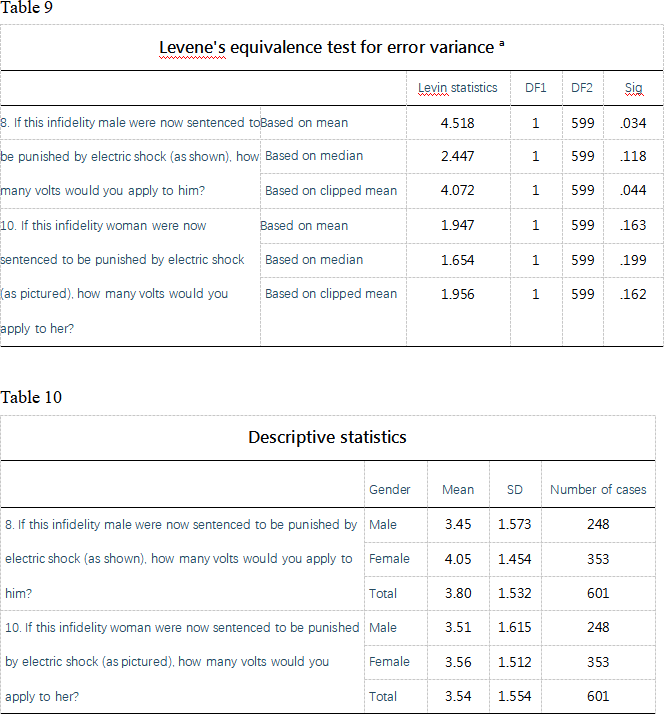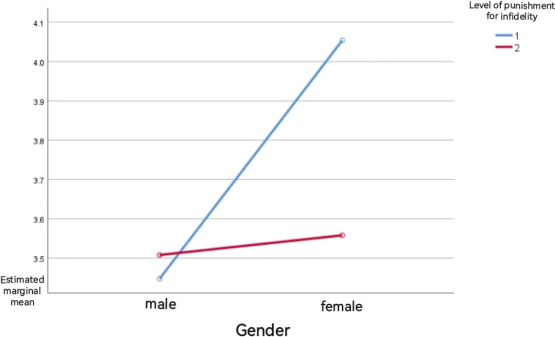SS5799 Study 2
Hello, dear friend, you can consult us at any time if you have any questions, add WeChat: daixieit
Study 2
Study purpose
To investigate whether public attitudes toward people with infidelity differ by gender and who has more internal consistency in their Target participants: Mainland Chinese residents of different genders, ages, and occupations.
Target participants:
Mainland Chinese residents of different genders, ages, and occupations.
Research Method: Questionnaire survey
Questionnaires were distributed to mainland Chinese residents of different genders, ages, and occupations to investigate the public's attitudes toward people with infidelity of different genders and their willingness to punish the infidelity person.
Instruments or Materials
1. A designed questionnaire.
2. Wenjuanxing questionnaire applet (a platform providing functions equivalent to Amazon Mechanical Turk.)
3. SPSS software.
Research Process and Procedures
This section utilizes a questionnaire to conduct an in-depth investigation into the public's perception of marital infidelity. The questionnaire is divided into two parts, the first of which is descriptive data, including the age, gender, occupation, education, and emotional and marital status of the test subjects. The second part of the questionnaire asks the respondents to investigate their attitudinal tendencies by assuming a specific situation of marital infidelity, such as "The couple pictured below is in a heated argument because one of them is cheating on his or her husband. In your opinion, the one who cheated is", "If this infidelity male were now sentenced to be punished by electric shock (as in the picture), how many volts of electric shock would you apply to him?" etc. The questionnaire questions were mainly multiple choice and Likert scale questions with only one option per question. The questionnaire was expected to take 2-3 minutes to complete in its entirety. (See Appendix for specific questionnaire)
Procedure of Data Collection
Design the questionnaire, distribute the questionnaire, collect the valid questionnaires, analyze the questionnaire data, and derive the attitudes of male and female respondents.
Questionnaire Distribution and Collection
From May 8, 2023, to May 30, 2023, questionnaires were distributed through the Questionnaire Star platform, and online random questionnaires were administered to 601 mainland Chinese residents (248 males and 353 females) of different genders, ages, and occupations from different provinces. The respondents were generally concentrated in the age group of 20-25 years old, which is consistent with the requirements of the study and statistically significant among the survey samples.
In the distribution and recovery of questionnaires, a total of 800 questionnaires were distributed and 606 were recovered, with a recovery rate of 76%, of which 601 were valid questionnaires, with a validity rate of 99%.
Statistical analysis of survey results
1. Characterization of respondents.
According to the 601 valid questionnaires, there are 248 males and 353 females among the respondents, with a ratio of about 4:6. The age of the respondents is mainly concentrated in the age group of 20-25 years old, with students and university degree holders accounting for the largest proportion of the respondents, and there are more both unmarried singles and married and childbearing persons. Specific data are shown in Tables 1-5.

2. Content analysis of the survey.
Questions 6-10 of the questionnaire were specifically analyzed in order to derive attitudinal tendencies of the male and female subjects. Firstly, the obtained data were compared with the between-subjects effect test.
The interaction between the cheater's gender and the respondent's gender was significant (p﹤0.05), indicating that the gender of the subjects had an effect with their evaluation of the cheater of different genders.

The questions in the second part of the questionnaire were next analyzed by comparing means in groups.
Judgment question 6 - Who cheated on his wife: Compared to women, men think women are more likely to cheat on their husbands. (1.23﹥1.12) Specific data are shown in Table 7.

Judgment question 7-male cheating, marriage breakup: men are more inclusive of male cheating and believe that women are also at fault. (1.88﹥1.69)
Judgment question 9 - female cheating, marriage breakup: women are more inclusive of female cheating. (2.07﹥1.90) Specific data are shown in Table 8.

Judgment Question 8-Punishing infidelity men: males are punished less severely by male subjects. (3.45﹤4.05)
Judgment question 10-Punishment strength for infidelity females: no significant difference between males and females. (p﹥0.05) Specific data are shown in Table 9, Table 10 and Figure 1.

Figure 1
Estimated marginal mean

Figure 1 Estimated marginal mean
Conclusion:
There is no difference between men and women in judging and penalizing female infidelity, and there is a difference between men and women in male infidelity. Men are more inclusive and less punitive about male infidelity.
Comparing questions 7 and 9, females will judge infidelity issue more as the male's fault.
Comparing questions 8 and 10, women are the harshest on male infidelity compared to the other combinations.
In addition, infidelity behavior by either the male or female partner in a marriage is generally perceived as favoring the male partner's problem.
The above findings are consistent with our hypothesis 1, "Men's attitudes toward infidelity people differ by gender, with men being tolerant and women being harsh," but the findings differ from hypothesis 2, "There is no significant difference in women's attitudes toward infidelity behavior of different genders." This may be related to the background of our respondents in terms of age group, education, etc., which will be discussed later in the Discussion section.
2023-07-17